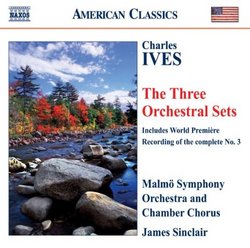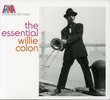| All Artists: Ives, Sinclair, Malmo Symphony Orchestra, Malmo Chamber Chrous Title: Charles Ives: The Three Orchestral Sets Members Wishing: 1 Total Copies: 0 Label: Naxos American Classics Original Release Date: 1/1/2008 Re-Release Date: 5/27/2008 Genre: Classical Styles: Historical Periods, Modern, 20th, & 21st Century, Symphonies Number of Discs: 1 SwapaCD Credits: 1 UPC: 636943935323 |
Search - Ives, Sinclair, Malmo Symphony Orchestra :: Charles Ives: The Three Orchestral Sets
 | Ives, Sinclair, Malmo Symphony Orchestra Charles Ives: The Three Orchestral Sets Genre: Classical
|
Larger Image |
CD DetailsSimilar CDs
|
CD ReviewsFrom Personal Experience David Gray Porter | Anaheim, California | 06/19/2008 (5 out of 5 stars) "I was privileged to hear the first performance in 1993 of the original versions of "St. Gaudens" and "Housatonic." While they may lack some of the added complexities of the revised 1929 version, they are still impressive. I have edited the original 1910 piano solo version of "St. Gaudens" (recorded by Don Berman on the "Unknown Ives No. 2" CD) and this first draft for orchestra (the manuscript of which I have studied) follows it almost exactly. The opening measure and the Coda of the later version of "St. Gaudens" did not in fact exist until 1929, and if this first version had indeed been performed in 1912, it would probably be the only one we would know today. The original draft of "Housatonic" follows the song version very closely, ending on the big B-flat major chord and not the tone-cluster of the later version. I am very happy to finally hear the orignal draft of "Putnam's Camp, as I had the opportunity to study the manuscript of this version back in 1998. Ives was initially unsure about retaining the opening measures found in the later version of "Putnam's Campp" (iniotialy written for the "Country Band March" of 1903) and he eventually decided to omit them i this 1912 draft, ony to reinstate them in 1929. Regarding the Third Orchestral Set, some have asked me how much of these pieces are by Ives and how much are by myself and Nors Josephson. I began my study of these manuscripts in 1976 when I was working on my MA thesis, and Nors was a member of my committee. The first movement was beguin in 1909 when Ives was planning a fourth movement to his Third Symphony. When he began writing the piece in earnest in 1919, he completed his draft up to the ending section, where he stopped working on the piece for another 7 years. Every section is more or less all there, and my only real work was to write out his background ostinati aganist the completed main lines. The final section is written hastily and it is not clear at first which of the parts is the main line (hence my confusion in realizing my first draft of the score in 1978), but it is compositionally complete and did not need any of my intervention (no "reconstruction," just plain editing). The second movement was trickier: Ives writes the background parts out in different places in the sketches than the foreground parts, linking them cryptically (when linked a all) with signs and memoranda. The weakness of this movement stems (in my mind) directly fro his use of both the 1904 version of the Trio from the "1776 Overture" and the later version from the first draft of "The Fourth of July" (which lacked many of the details of the final draft frm the 1920s). Yet this is what Ives explicitly calls for, first as the band rehearses and then as it marches home from the train station. The crazy quodlibet in the town center that makes up the center of the piece is fully worked out, but again, in two separate sketches of separate leaves. My only "reconstruction" or editorial invention occurred in completing the opening from what Ives began (a completion of the apreggiating chord) and linking the end of the first Trio march to the beginnig of the quodlibet (where the piccolo plays Reveille), but here again I have simply continued what Ives began, working from each end of the gap to its center. Nors's work on the third movement is remarkable. It may be to the initial reviewer that he has merely strung the sketches together, but after some 30 years of working with this manuscript, I was deeply impressed with what he did. Nors's additions are very few -- a bass note under the tutti glissando following the movement's climax, for example -- but his vision of how the piece would have been put together in a final draft by Ives is a true vision. There were a few sketch materials that he chose not to use, but not many -- most of these were sketched variations of the harp figure that winds through most of the piece. I take strong issue with the idea of "picking over Ives's bones" in the completion of these pieces -- the comment is reminiscent of a certain music critic's objections to the "finishing up" of Ives's "Emerson" Piano Concerto and the 2nd through 5th movements of Mahler's Tenth Symphony (I have also studied the sketches of Mahler's Tenth), and is not warranted when one knows the materials. -- David Gray Porter, Editorial Coordinator for The Charles Ives Society " Editors fail to summon the spirit of Charles Ives Joe Barron | Philadelphia, Pennsylvania United States | 06/09/2008 (3 out of 5 stars) "It is time to stop picking over Charles Ives's bones in hopes of putting together yet one more realization. At his death, Ives left sketches for a Third Orchestral Set, and on this disk, James Sinclair and the Malmo Symphony present the premiere performance of the work, which was edited, realized or completed -- pick your process -- by David Gray Porter and Nørs Josephson. The result occupies a considerably lower stratum in the Ives canon than the first two orchestral sets, which are also recorded here. In the booklet, Ives biographer Jan Swafford calls the third movement an "uncanny" example of Ives' late "sublime style," the pinnacle of which is the finale of the Fourth Symphony. It doesn't come close. It lacks the three-dimensionality and the sense of space Ives most likely would have added had he summoned the energy to complete it. Whereas his mature, completed orchestral music proceeds on several levels, this piece, titled simply "Andante," sounds two-dimensional, as if Josephson had laid the sketches out end to end, expanding them in time but not in space. The first two movements feel like rehashes of earlier pieces. One hears echoes of "Thanksgiving" and "The Robert Browning Overture" but without the grandeur, drive or urgency of those works. At 28 minutes, the Third Orchestral Set is almost as long as its two predecessors combined, yet only half as full. The good news is that Sinclair's readings of the first two orchestral sets on this CD are very fine indeed. He gives us yet another version of the first, better known as "Three Places in New England," bringing the total to four: the 1929 chamber version Ives prepared for Nicholas Slonimsky; a revision of the chamber version prepared for publication in 1935; the so-called original orchestration, which is really an expansion for full orchestra of the 1929 chamber version, prepared by James Sinclair in the 1970s; and this, the "First Version," the earliest of the lot. Ives completed the score about 1914, and according to Swafford, he pared down the complexities of his initial sketches to make it more palatable to the orchestras of the time. It didn't happen, and perhaps we should be grateful. The later, restored versions are tighter and more exciting, especially in the Putnam's Camp movement, which here lacks both the explosive opening and the riotous finale. Still, it is essentially the same piece, and unmistakably Ives. Sinclair and company capture the ghostly lyricism of the first movement, here titled "Impression of the St. Gaudens in Boston Common," almost as well as Levine and the BSO did when I heard them perform it live a few years ago. Believe me, that is high praise. And the last movement, famous "Housatonic at Stockbridge," retains all of its mystery and power on this CD. The Second Orchestral Set, another true example of the sublime style and one of Ives's greatest scores, is also well served in this recording. I recommend this CD for its performances of the music Charles Ives actually finished and sent out into the world. The Third Orchestral Set, completed by others who lack his audacity and vision, offers little more than a historical footnote. " Charles Ives's two and one-half orchestral sets Robin Friedman | Washington, D.C. United States | 06/25/2008 (4 out of 5 stars) "James Sinclair, the music director of the Orchestra New England and an authority on the music of Charles Ives, is in the midst of recording all Ives's orchestral music for the budget-priced Naxos label. In this CD, his most recent release, Sinclair conducts the Malmo Symphony Orchestra, Sweden, in Ives's three orchestral sets. The Malmo Chamber Chorus participates as well in the final movement of the second set. The Malmo Symphony was unknown to me, and it plays with beauty, polish, and an Ivesian spirit on this recording.
The sets are late works of Charles Ives in which he attempted to break down traditional musical forms and compose in a distinctly personal and American idiom. The music is programmatic in character with Ives giving each movement an evocative and musically appropriate title. Ives completed the first two orchestral sets, and they are masterful. Ives left only sketches for the third orchestral set. It has been reconstructed by two Ives scholars and appears on recording here for the first time. The two prior Amazon reviewers, including one of the editors of the piece, have offered detailed views on the merits of the reconstruction. In general, I am uncomfortable with reconstructions of works that the composer, for whatever reason, failed to complete. I remain so after hearing this reconstructed Ives's third set. Regardless of how much of this work is Ives's own and how much is the editors, the piece is long and diffuse. It does not work well as music. Most listeners, especially those new to Ives, will not have their feelings for his music enhanced by the third orchestral set. Those listeners wanting to hear Ives at his best should turn to the first two orchestral sets and leave this reconstructed third set to specialists. With that said, the performances of orchestral sets one and two are outstanding. The first set is frequently known by the title "Three Places in New England." In this recording, Sinclair uses an early edition that Ives prepared of this score that lacks some of the complexity and dissonance of the later, more familiar versions. The music thus has much to offer to both newcomers and committed Ivesians. In the first movement, Ives offers a musical portrait of the famed St Gaudens statue in Boston (and in Washington D.C.'s National Gallery of Art) which celebrates Robert Gould Shaw and his African American regiment of Civil War soldiers, later featured in the movie "Glory" for their attack on Fort Wagner, South Carolina. The music is slow and stately with an underlying march motif and quotations from hymns that leads to a stirring climax. The second lively and raucous movement features a collage of tunes juxtaposed together and is called "Childrens Holiday at Putnam's Camp". The famous third movement, "The Housatonic at Stockbridge" features the hushed flow of the river set against a majestic hymn tune. Ives wrote this movement to celebrate his marriage and honeymoon. The second orchestral set is less often performed than the first and deserves to be heard more often. It is short but intense. The opening movement, "An Elegy to our Forefathers" features a zither, harp, percussion, and bells which begin the work quietly and assume prominence, together with a solemn theme, as the movement progresses. The middle movement "The Rockstrewn Hills Join in the People's Outdoor Meeting" is a collage of musical moments, filled with revival spirit and ragtime rhythm. The finale "From Hanover Square North, at the End of a Tragic Day, the Voice of the People again arose" commemorates the sinking of the Lusitania during WW I. The music begins with a choral hymn, sung in hushed tones, and moves gradually to a powerful climax played with a great sense of hope and vision. I was not impressed with the reconstructed third orchestral set. But the remainder of this CD will introduce the listener to essential works of Charles Ives, who remains the quintessential American composer. Robin Friedman" |

 Track Listings (9) - Disc #1
Track Listings (9) - Disc #1



